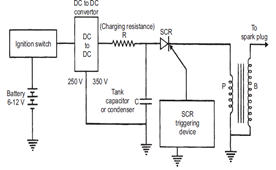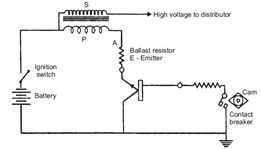←
Automobile Engineering
Electronic Ignition System
Introduction:
Electronic ignition systems use some solid state devices like transistor and capacitors, etc. to generate right sparking voltage at right time. These systems have overcome the limitations of conventional (battery ignition and magneto-ignition) ignition systems. Modern automobiles make use of these systems. These systems are more reliable and require less maintenance. Wear and tear of components is reduced and life of spark plugs is increased with the use of electronic ignition.

Capacitance Discharge Ignition System

- Whenever the SCR triggering device, sends a pulse, then the current flowing through the primary winding is stopped. And the magnetic field begins to collapse.
- This collapsing magnetic field will induce or step up high voltage current in the secondary, which while jumping the spark plug gap produces the spark, and the charge of air fuel mixture is ignited.
Transistorized Assisted Contact (TAC) Ignition System
Advantages
- The low breaker-current ensures longer life.
- The smaller gap and lighter point assembly increase dwell time minimize contact bouncing and improve repeatability of secondary voltage.
- The low primary inductance reduces primary inductance reduces primary current drop-off at high speeds.
Disadvantages

- As in the conventional system, mechanical breaker points are necessary for timing the spark.
- The cost of the ignition system is increased.
- The voltage rise-time at the spark plug is about the same as before.
Piezo-electric Ignition System
- The development of synthetic Piezo-electric materials producing about 22 kV by mechanical loading of a small crystal resulted in some ignition systems for single cylinder engines.
- But due to difficulties of high mechanical loading need of the order of 500 kg timely control and ability to produce sufficient voltage, these systems have not been able to come up.
The Texaco Ignition System
- Due to the increased emphasis on exhaust emission control, there has been a sudden interest in exhaust gas recirculation systems and lean fuel-air mixtures.
- To avoid the problems of burning of lean mixtures, the Texaco Ignition system has been developed. It provides a spark of controlled duration which means that the spark duration in crank angle degrees can be made constant at all engine speeds.
- It is an AC system. This system consists of three basic units, a power unit, a control unit and a distributor sensor.